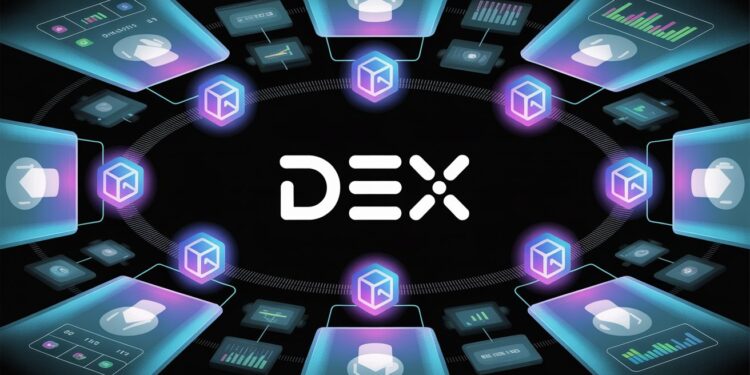What Is a Decentralized Exchange (DEX)?
With the ongoing evolution of blockchain and cryptocurrency, DeFi stands out as a major breakthrough in the financial sector. One of its most significant innovations is the Decentralized Exchange, commonly referred to as a DEX. But what exactly is a DEX, and how does it differ from the traditional exchanges we’re used to?
Let’s dive deep into the world of decentralized exchanges, understand how they work, their pros and cons, and why they’re gaining traction in the crypto ecosystem.
Understanding the Basics: What Is a DEX?
A Decentralized Exchange (DEX) is a type of cryptocurrency exchange that operates without a central authority. Instead of relying on a company or institution to facilitate trading, DEXs use smart contracts and blockchain protocols to enable peer-to-peer (P2P) transactions.
This means users trade cryptocurrencies directly with one another, without needing to deposit funds into the exchange. Unlike centralized exchanges (CEXs) like Binance, Coinbase, or Kraken, a DEX allows users to retain full control of their private keys and wallets.
Centralized vs. Decentralized Exchanges: What’s the Difference?
To truly grasp the value proposition of DEXs, it’s essential to understand how they differ from centralized exchanges.
| Feature | Centralized Exchange (CEX) | Decentralized Exchange (DEX) |
|---|---|---|
| Control of funds | Held by the exchange | Held by the user |
| KYC/AML requirements | Usually mandatory | Often not required |
| Speed | Fast, due to centralized servers | Can be slower, depending on blockchain traffic |
| Custodianship | Custodial | Non-custodial |
| Risk of hacks | Higher, due to centralized storage | Lower, as funds are held by users |
| Privacy | Limited | Enhanced privacy |
In essence, centralized exchanges offer convenience, while DEXs offer security and privacy.
How Does a DEX Work?
At its core, a DEX leverages smart contracts—self-executing contracts with terms written directly into code. When you place a trade on a DEX, you’re interacting with these smart contracts.
Here’s a simplified breakdown of the process:
- User connects a crypto wallet like MetaMask, Trust Wallet, or Coinbase Wallet.
- The DEX displays available trading pairs.
- The user initiates a trade directly from their wallet.
- A smart contract executes the trade automatically, swapping tokens between parties.
- The tokens are delivered to the respective wallets—no middleman involved.
All transactions are transparent and verifiable on the blockchain.
Types of DEX Models
There isn’t just one way to build a DEX. Different models cater to different user needs and technical approaches:
1. Order Book DEX
Similar to traditional exchanges, order book DEXs display a list of buy and sell orders. They can be on-chain or off-chain:
- On-chain order books store orders directly on the blockchain (e.g., Loopring).
- Off-chain order books keep orders off-chain but settle trades on-chain (e.g., IDEX).
2. Automated Market Makers (AMMs)
The most popular model today, AMM-based DEXs (like Uniswap, SushiSwap, and PancakeSwap) replace order books with liquidity pools. Here’s how they work:
- Users (liquidity providers) deposit pairs of tokens into a pool.
- Traders swap tokens from the pool, with prices determined by a mathematical formula (typically x*y=k).
- In return, liquidity providers earn a share of the trading fees.
3. Aggregators
DEX aggregators like 1inch or Matcha scan multiple DEXs to find the best price and route your trade efficiently. They help users avoid slippage and high gas fees by spreading trades across multiple platforms.
Advantages of Using a DEX
So why would someone choose a DEX over a centralized exchange? Here are some of the biggest benefits:
1. Full Control Over Funds
With DEXs, you own your private keys, meaning you’re in full control of your crypto. There’s no risk of an exchange locking your account or freezing your assets.
2. Enhanced Privacy
Most DEXs do not require you to register or go through Know Your Customer (KYC) checks. This provides users with a high level of anonymity and privacy.
3. Security Against Hacks
Centralized exchanges are prime targets for hackers due to their large holdings. DEXs mitigate this risk by keeping user funds in individual wallets until the moment of trade.
4. Access to New and Diverse Tokens
New tokens often launch on DEXs before hitting centralized platforms. DEXs allow access to a broader range of tokens, especially in early stages.
5. Censorship Resistance
Since DEXs run on decentralized protocols, it’s nearly impossible for any government or organization to shut them down or block specific users.
Challenges and Limitations of DEXs
While DEXs have their advantages, they aren’t without flaws.
1. User Experience Can Be Complex
DEXs are not beginner-friendly. Users need to understand how wallets, gas fees, slippage, and token standards work.
2. Gas Fees and Network Congestion
DEXs operating on Ethereum or similar blockchains can suffer from high gas fees, especially during peak network usage.
3. Slippage and Impermanent Loss
When trading illiquid tokens or large amounts, slippage (difference between expected and actual price) can occur. Liquidity providers also risk impermanent loss due to price fluctuations.
4. Lack of Fiat Support
DEXs typically don’t support direct fiat transactions. You’ll need crypto to start trading, which often means purchasing from a centralized exchange first.
5. Smart Contract Risks
Even though DEXs reduce risks from human error or centralized hacks, they’re still vulnerable to bugs or exploits in smart contracts. Always trade on audited and reputable platforms.
Popular Decentralized Exchanges in 2025
Several DEXs have grown to become household names in DeFi. Some of the most popular include:
1. Uniswap
- Built on Ethereum
- AMM model
- Most traded and well-established DEX
2. PancakeSwap
- Built on Binance Smart Chain (BSC)
- Lower gas fees
- Gamified features like lotteries and farms
3. SushiSwap
- Multi-chain support
- Advanced DeFi tools like lending and yield farming
4. Curve Finance
- Specializes in stablecoin swaps
- Very low slippage
5. 1inch
- DEX aggregator
- Smart routing and low slippage
How to Use a DEX: Step-by-Step Guide
Getting started with a DEX isn’t as intimidating as it may seem. Here’s a quick guide:
- Set Up a Wallet
- Install MetaMask or Trust Wallet.
- Fund it with ETH, BNB, or the relevant network token.
- Choose a DEX
- Visit the DEX’s official website (e.g., app.uniswap.org).
- Connect Your Wallet
- Click “Connect Wallet” and authorize the connection.
- Select a Trading Pair
- Choose the tokens you want to swap (e.g., ETH → USDC).
- Set Slippage and Gas Fee
- Adjust slippage tolerance if needed. Confirm the gas fee.
- Confirm and Execute the Trade
- Approve the token for trading.
- Confirm the swap, and wait for transaction confirmation.
The Future of DEXs
As blockchain scalability improves and more user-friendly tools are developed, DEXs are poised to play a central role in the future of finance. Features like:
- Layer 2 scaling (e.g., Arbitrum, Optimism)
- Cross-chain compatibility
- Improved UI/UX
…will only make DEXs more accessible to the average user.
Furthermore, regulatory clarity may also lead to the emergence of regulated DEXs—combining the best of decentralization with legal compliance.
Final Thoughts
Decentralized exchanges represent one of the most powerful ideas in the crypto space—financial freedom without middlemen. While they come with a learning curve and certain risks, the benefits of privacy, control, and transparency are undeniable.
Whether you’re a crypto veteran or just stepping into the DeFi world, understanding DEXs is crucial. They are not just a tool for trading, but a symbol of what decentralized finance stands for: autonomy, openness, and innovation.
As we move forward into a more decentralized future, DEXs will likely become as common and essential as email or social media. Now is a great time to learn, experiment (safely), and embrace this shift in financial power.
Join Us : Twitter | Website | GitHub | Telegram | Facebook | YouTube

























